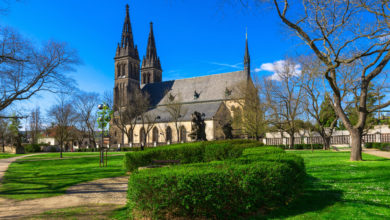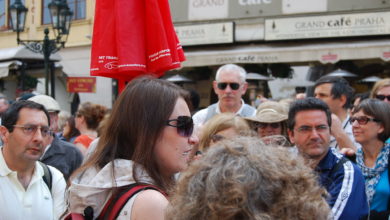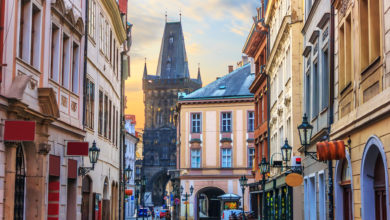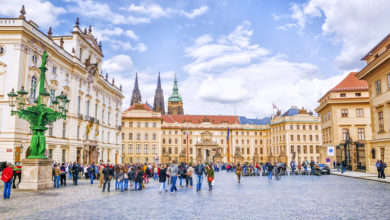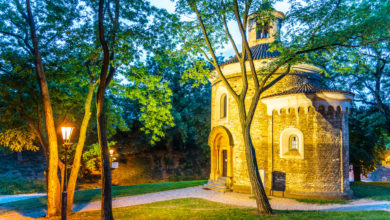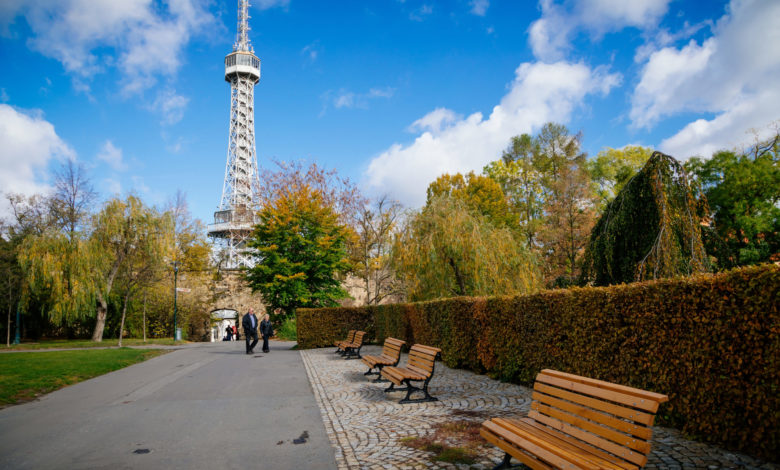
As a vantage point looking out over Prague, Petřín is hard to beat, especially if you climb to the top of its 60 metre-high Lookout Tower. But there’s also no dearth of things to do in Petřín itself, filled as it is with picturesque gardens, quaint attractions, and plenty of winding paths to explore.
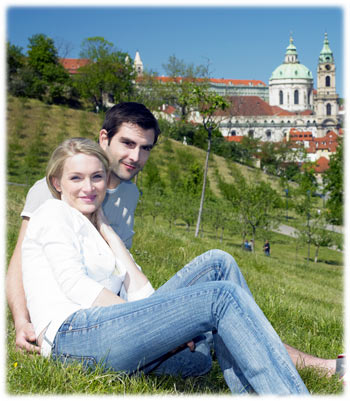
The below-listed tour can be walked on your own (self-guided tour), or we can arrange for you a professional English-speaking guide. The tour guide can even tailor this walk to your special needs; for example, recommend a place to stop for lunch, including a river cruise or tram ride if you are tired of walking, etc. The guide can pick you up at your hotel, or you can arrange to meet anywhere in the city. Please email us your details for a price quote.
1. Kinský Square to the Hunger Wall. It is told that the Kinsky legacy began over 1000 years ago when a young man saved the King’s daughter from a pack of wolves. As a result, he was ennobled and awarded a coat of arms displaying the three wolves’ teeth. This can still be seen today in the coat of arms hanging over the door of the Kinsky Palace in Old Town Square.
The Kinský Gardens were established in 1827 by Prince Rudolf Kinsky, who wanted to create an English-style retreat for his family. There are almost 22 hectares here, located in fairly rugged terrain, at altitudes reaching up 318 meters. Entering the Gardens through a large enclosed gateway, if it’s summer, you may be hit with the pungent waft of garlic, which has been transported here all the way from Asia.
Take the wide path on your left towards the Renaissance-style Michna Palace, which the Kinsky’s used as their summer house. Building of the Palace – overseen by architect Jindřich Koch in the 1830s – was not easy, as the gardens lie on a slope, and the terrain had to be significantly levelled in several places for the structure to sit straight. Today it is a museum of ethnography. Next to the Palace is a statue of the Czech actress Hana Kvapilová, who had firm ties with the golden-topped National Theatre that stands across the Vltava. Around 50m (150ft) above the Palace is its artificial lower lake. Keep heading uphill, passing as you do, the 18th century Church of St Michael. This wooden folk church was transferred here from Medvedovce – a small Ukrainian village – in 1929.
Follow the path upwards for about 20m (60ft), then head to the top of the steps to a wide asphalt path, where you might want to stop for a breather while marvelling at the views starting to unfold below. Branch right now, and further up on your left, you’ll see Kinský Garden’s upper lake, which is presided over by a lonely-looking bronze seal. Continuing up the path, you’ll be met by a Neo-Gothic gate. As you walk through it, you are entering Prague’s old Baroque fortifications.
2. Hunger Wall to Petřín Lookout Tower. Continuing along the path, the Hunger Wall comes into view. This medieval defence runs the length of Újezd, across Petřín Hill and right up to Strahov Monastery. Because of its jagged nature was originally named ‘Zubatá’ (‘with teeth’). Although records state the Hunger Wall was commissioned in 1360 by Charles IV to strengthen the defences of Prague Castle, another myth suggests it was a pointless structure built only to provide work for the poor during a desperate time of famine. This is where its extant name derives from.
Take the wide path to the left below the Wall and carry on up the Hill beside the Wall, crossing the bridge which spans the funicular railway (originally opened in 1891). If you fancy a ride on the funicular, your tram or metro ticket is valid; it’s public transport, after all. Now might be the time to stop off for something to eat; below your right is the Nebozízek restaurant. Refreshed, continue to the Hill’s summit. To your right is the Mirror Labyrinth, which fascinatingly imitates the Gothic fortifications at Vyšehrad. Opposite this is the 12th-century St Lawrence’s Church, renovated into its current Baroque form in the 18th century. In the 10th century, a sanctuary was built here in place of a heathen site of sacrifice.
3. Petřín Lookout Tower to Strahov Monastery. From the centre of the space, you’re now in rises the Petřín Lookout Tower. This steel framework structure – which gives more than a passing nod to the Eiffel Tower – was built just two years after the Paris landmark in 1891. Although it is nowhere near as tall as the Eiffel Tower, the Lookout Tower does stand at a higher altitude because of its location. Turn left and follow signs to the Rose Garden.
This beautiful Rosarium was planted by Prague in 1932 and took on three different patterns – a fan, a circle and a parterre. Stargazers among you will be interested in checking out Štefánik’s Observatory, which was founded in 1928 and named after Slovak astronomer Milan Rastislav Štefánik, a statue of whom stands outside.
Saunter back to the Lookout Tower, follow the wall on the left, passing a few chapels of the Stations of the Cross, dating from 1834. Next, pass through a gap in the Hunger Wall, turn right, and see a lovely little Baroque house. About 50m (150ft) beyond this, there’s another gap in the Hunger Wall on your right, which you should walk through. Now turn left into the orchard above Strahov Monastery for more spellbinding views of the city. Exit how you came in, turn right and head down the hill along the wall, through the orchard and past the tennis courts to the Strahov Monastery courtyard. Tram no. 22 will take you back to Prague city centre. And if you have time, it’s recommended you stay awhile to visit the astounding Philosophical and Theological Halls of Strahov’s Library, then to sup on the tasty beer from its brewery.

